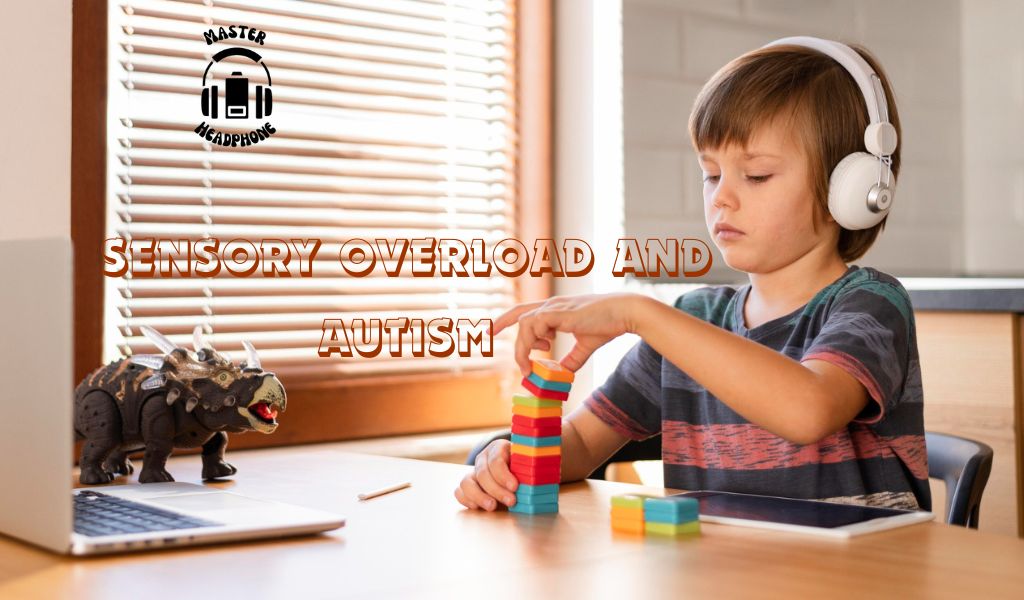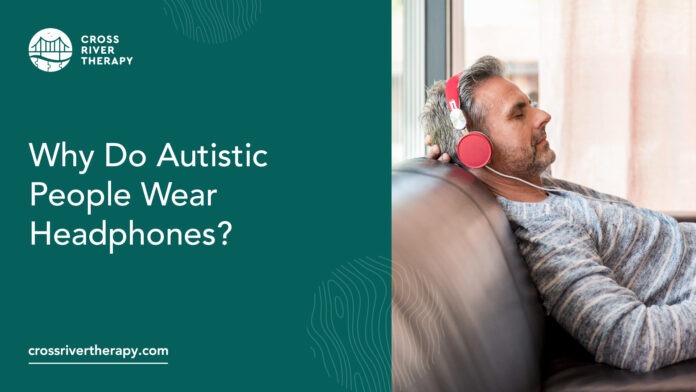Autistic people wear headphones to block out overwhelming noise and sensory stimuli, which can provide a sense of calm and focus, and in some cases may help them communicate better with others. Many autistic individuals may feel overstimulated by sights, sounds, smells, and touches, leading to feelings of stress and being overwhelmed.
Some autistic individuals use headphones to ease sound sensitivity and create comfort in their environment. This can help them manage sensory overload and prevent distress caused by the surrounding stimuli. For those with autism, wearing headphones can be a beneficial tool for enhancing concentration and communication, allowing them to navigate their environment more effectively and engage with others in a way that suits their individual needs.
Sensory Overload And Autism

Autistic individuals may wear headphones as a means of coping with sensory overload, a common experience in autism spectrum disorder. Sensory overload occurs when the brain receives more information than it can process, leading to feelings of overwhelm and stress.
Effects Of Sensory Overload
Sensory overload can trigger an array of adverse effects, including anxiety, meltdowns, and a reduced ability to focus. Additionally, it can impact an individual’s social interactions and overall well-being.
Sensory Processing Differences In Autism
People with autism often have differences in sensory processing, causing them to be hypersensitive or hyposensitive to sensory stimuli. This can lead to heightened reactions to noise, light, touch, and other sensory inputs, leading to the need for strategies such as using headphones to manage overwhelming sensory experiences.
Coping Mechanisms For Sensory Overload
Autistic individuals wear headphones as a coping mechanism for sensory overload. The headphones help block out overwhelming sounds, providing a sense of calm and focus. This may also help improve communication and reduce stress for autistic individuals.
Use Of Headphones And Earplugs
Autistic individuals often utilize headphones and earplugs as a coping mechanism for sensory overload. The use of these tools allows them to create a more manageable auditory environment, providing relief from overwhelming noises.
Benefits Of Noise Reduction For Autistic Individuals
Noise reduction through headphones and earplugs offers significant benefits to autistic individuals, aiding in the alleviation of sensory overwhelm. These tools help in minimizing the impact of environmental stimuli, allowing for a greater sense of calm and focus, and facilitating improved communication.
Individuals on the autism spectrum frequently experience hypersensitivity to various sensory inputs, including auditory stimuli. This resultant sensory overload can lead to heightened stress and discomfort. To address these challenges, many autistic individuals resort to wearing headphones or earplugs as a means of managing the overwhelming sensory input.
By utilizing headphones and earplugs, autistic individuals can effectively reduce the intrusion of excessive noise, providing a way to regulate their sensory experiences and create a more comfortable environment for themselves. This reduction in auditory stimuli can lead to a decrease in anxiety and stress, enabling them to navigate their surroundings with greater ease and comfort.
Impact On Daily Functioning
Autistic people wear headphones
Autistic people wear headphones to reduce sensory overload, making daily functioning more manageable. Headphones help block overwhelming noise and stimuli, providing a sense of calm and focus, and improving communication with others. These tools are essential for individuals on the autism spectrum to navigate the challenges of their environment.
Impact on Daily Functioning: Autistic people often wear headphones to cope with sensory overstimulation, which impacts their daily functioning significantly. The auditory hypersensitivity experienced by many individuals on the autism spectrum can make it challenging to focus, communicate, or simply navigate through various environments without feeling overwhelmed.
Role Of Headphones In Managing Overstimulation
Headphones play a crucial role in managing overstimulation for autistic individuals. By wearing headphones, they can effectively control the noise levels in their environment, reducing the impact of overwhelming sounds. This helps in creating a more comfortable and conducive setting for them to manage their sensory challenges and carry out daily activities with greater ease.
Utility Of Headphones In Different Environments
The utility of headphones extends across various environments where autistic individuals may encounter sensory triggers. Whether in crowded public spaces, bustling workplaces, or even at home, headphones provide a reliable tool for creating a soothing auditory environment. This allows them to participate in social interactions, engage in learning, or concentrate on tasks without being overwhelmed by external noises. In educational settings, noise-cancelling headphones have shown to significantly improve task performance for students with ADHD, indicating their utility in facilitating focus and productivity. Similarly, in everyday scenarios, headphones empower autistic individuals to navigate through sensory-rich environments with a heightened sense of control and comfort.
Understanding Individual Sensory Needs
Varied Sensory Sensitivities In Autism
Autistic individuals often experience heightened sensitivities to sensory input, including sound, touch, and light. These sensitivities can lead to sensory overload, causing distress and discomfort. Some individuals may find certain noises overwhelming or even painful, making it challenging to navigate everyday environments.
Personalized Approaches To Sensory Regulation
Each autistic individual has unique sensory needs, and it’s essential to recognize that there is no one-size-fits-all approach to sensory regulation. Personalized strategies, including the use of headphones, provide a means for individuals to manage their sensory experiences based on their specific sensitivities.
For autistic individuals, wearing headphones can serve as a tool to block out overwhelming noise and sensory stimuli, creating a more comfortable and manageable environment. This can help reduce sensory overload, minimize distress, and promote a sense of calm and focus. Furthermore, headphones can facilitate better communication in some cases, allowing individuals to engage more effectively with others in challenging auditory environments.
In conclusion, recognizing and accommodating the varied sensory sensitivities of autistic individuals through personalized sensory regulation approaches, such as the use of headphones, is crucial for promoting comfort, well-being, and improved quality of life.
Creating Inclusive Environments
Importance Of Accommodating Sensory Needs
Autistic individuals often experience sensory sensitivities, leading to difficulties in processing and coping with various stimuli. These sensitivities can manifest in heightened responses to sounds, lights, textures, and other sensory inputs. Wearing headphones allows autistic individuals to manage and regulate the sensory input, providing a sense of control and comfort in their environment.
Supporting Autistic Individuals In Various Settings
In educational, work, and social settings, it is crucial to recognize and accommodate the sensory needs of autistic individuals. Promoting the use of headphones as a sensory management tool can create more inclusive and supportive environments. By acknowledging and addressing the sensory sensitivities of autistic individuals, we can foster a more inclusive and understanding atmosphere that promotes their well-being and success.
Frequently Asked Questions On Why Do Autistic People Wear Headphones?
Why Do Autistic People Wear Ear Plugs?
Autistic people wear earplugs to reduce sensory overwhelm and create a more comfortable environment. The earplugs lower the intensity of sounds, helping to block out overwhelming noise and sensory stimuli. This can provide a sense of calm and focus, aiding communication and reducing stress.
Why Do Headphones Help With Overstimulation?
Headphones help with overstimulation by blocking extraneous noise, providing a sense of calm and reducing sensory overwhelm. This can be particularly beneficial for individuals with autism, ADHD, or sensory sensitivity, enabling them to create a more comfortable environment for themselves.
Why Do People With Adhd Wear Headphones?
People with ADHD wear headphones to block out distractions and improve focus during tasks. Studies show significant performance improvement when using noise-cancelling headphones.
Why Do Autistic People Cover Their Ears?
Autistic individuals cover their ears to block out overwhelming sounds, which can cause distress. This act acts a coping mechanism to reduce sensory input.
Conclusion
For individuals with autism, wearing headphones serves as a valuable coping mechanism to combat overwhelming sensory stimuli. By reducing the intensity of sounds and creating a more comfortable environment, headphones provide a sense of calm and focus. Additionally, they may even aid in facilitating better communication with others.
Overall, headphones play a vital role in alleviating the challenges of sensory overload for autistic individuals.


